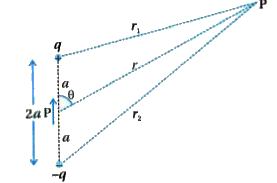Derive the formula for the electric potential due to an electric dipole at a point from it. Solution in Gujrati
A dipole is placed with origin at its midpoint. Its charge -q and +q is separated by a distance 2a. The magnitude of a dipole moment of the dipole is p= 2aq and its direction is from -q to +q.
Let point P away from the midpoint of dipole and r1 and r2 are the distance of P from +q and q respectively which is shown in the figure .

The potential due to the charge +q at point P is
V1k(+q)r1 and
The potential due to the charge -q,
V2=k(−q)r2=kqr2
According to superposition principle, the total potential at point P
V=V1+V2
=kqr1−kqr2
=kq[1r1−1r2]
Draw qN ⊥ OP In ΔqON∠qON=θ
∴ON=r−r1
and cosθ=ONOq⇒ON=Qqcosθ
∴r−r1=acosθ⇒r1=r−acosθ
=r(1−ar1rcosθ)
⇒r21=r2(1−arcosθ)2
=r2(1−2acosθr+a2r2cos2θ)
=r2(1−2acosθr)
Putting r>>a⇒a2r2=0
and draw OM ⊥ (-qp=P) then in Δ− qOM P(-q) M =θ and (-q) M =r2−r
∴cosθ(−q)MO−(−q)⇒(−q)M=mO(−q)cosθ
∴r2−r=acosθ
:>r2=r+acosθ
∴r2=r(1+arcosθ)
Similarly r22=r2(1+2acosθr)
Now from equation (4 )
∴1r1=1r(1−2acosθr)−1/2
=1r(1+acosθr)
only two terms be taken from expansion and,
1r2=1r(1−acosθr)
Now from equation (5)
only two terms be taken from expansion .
⇒ Putting the values of equation (6) and (7) in equation (1) ,
V=kqr[(1+acosθr)−(1−acosθr)]
=kqr[2acosθr]
=k(p)cosθr2[∵2aq=p]
=k→P.→rr2[∵pcosθ=→P.ˆr]
∴V=p.ˆr4π∈0r2orpcosθ4π∈0r2orkpcosθr2
Hence potential due to a point charge decreases according 1r and potential due to a dipole decreases according to 1r2 distance . The molecular dipoles are very small and such an approximation is very well applicable to them.
Topper's Solved these Questions
- ELECTROSTATIC POTENTIAL AND CAPACITANCEBOOK - KUMAR PRAKASHANCHAPTER - ELECTROSTATIC POTENTIAL AND CAPACITANCEEXERCISE - ( Section -A) Try Yourself
50 Videos
- ELECTROSTATIC POTENTIAL AND CAPACITANCEBOOK - KUMAR PRAKASHANCHAPTER - ELECTROSTATIC POTENTIAL AND CAPACITANCEEXERCISE - Section B Numericals
16 Videos
- ELECTROMAGNETIC WAVESBOOK - KUMAR PRAKASHANCHAPTER - ELECTROMAGNETIC WAVESEXERCISE - BOARD.S QUESTION PAPER MARCH - 2020 (PART - B) SECTION - C
5 Videos
- MAGNETISM AND MATTERBOOK - KUMAR PRAKASHANCHAPTER - MAGNETISM AND MATTEREXERCISE - SECTION D Multiple Choice Questions (MCQs) (MCQs asked in Competitive Exams) MCQs asked in Board Exam and GUJCET
7 Videos
Similar Questions
What are conservative force , non - conservative force , conservative field and non - conservative field ?
View SolutionCalculate the potential at a point P due to a charge of 4×10−7 C located 9 cm away.
View SolutionDetermine the current in each branch of the given network.

View SolutionAt a place on earth the vertical component of earth's magnetic field is √3 times its horizontal component. The angle of dip at this place is …...
View Solutionकिसी विद्युत् द्विध्रुव के कारण किसी बिन्दु पर विद्युत् विभव होता है :
View SolutionDefine electric potential. Derive and expression for the electric potential due to an electric dipole and hence the electric potential at a point (a) the axial line of electric dipole (b) on the equatorial line of electric dipole.
View Solutionवैद्युत द्विध्रुव के कारण अक्षीय स्थिति में किसी बिंदु पर वैद्युत विभव के लिए व्यंजक व्युत्पन्न कीजिए। एकल आवेश के कारण किसी बिंदु पर विभव एवं वैद्युत द्विध्धुव के कारण किसी बिंदु विभव में एक अंतर लिखिए।
View Solutionकिसी विद्युत् द्विध्रुव के कारण किसी बिंदु (r,θ) पर विद्युत् विभव का व्यंजक व्युत्पन्न कीजिए | सिद्ध कीजिए कि अक्ष पर स्थित बिंदु पर विद्युत् विभव अधिकतम तथा निरक्ष पर विद्युत् विभव शून्य होता है |
View Solutionकिसी विद्युत् द्विध्रुव के कारण किसी बिन्दु पर विद्युत् विभव होता है :
View Solutionविद्युत द्विध्रुव के कारण किसी बिन्दु पर विद्युत विभव के सूत्र को व्युत्पन्न करो तथा अक्षीय स्थिति में विद्युत विभव ज्ञात करो, जबकि 2l << r है। जहाँ 2l दोनों आवेशों के बीच की दूरी व r द्विध्रुव के केन्द्र से उस बिन्दु की दूरी जिस पर विद्युत विभव ज्ञात करना है।
View SolutionDerive an expression for electrostatic potential due to an electric dipole.
View SolutionWhat is an electric dipole and electric dipole moment? Derive an expression for electric potential at any point due to an electric dipole. Also discuss the special cases.
View SolutionDerive an expression for electrostatic potential due to an electric dipole.
View SolutionDerive an expression for electrostatic potential due to an electric dipole.
View Solution(i) Derive the expression for the specific for the electric potential due to an electric dipole at a point on its axial line.
(ii) Depiet the equivpotential surfaces due to an electric dipole.
View Solution
